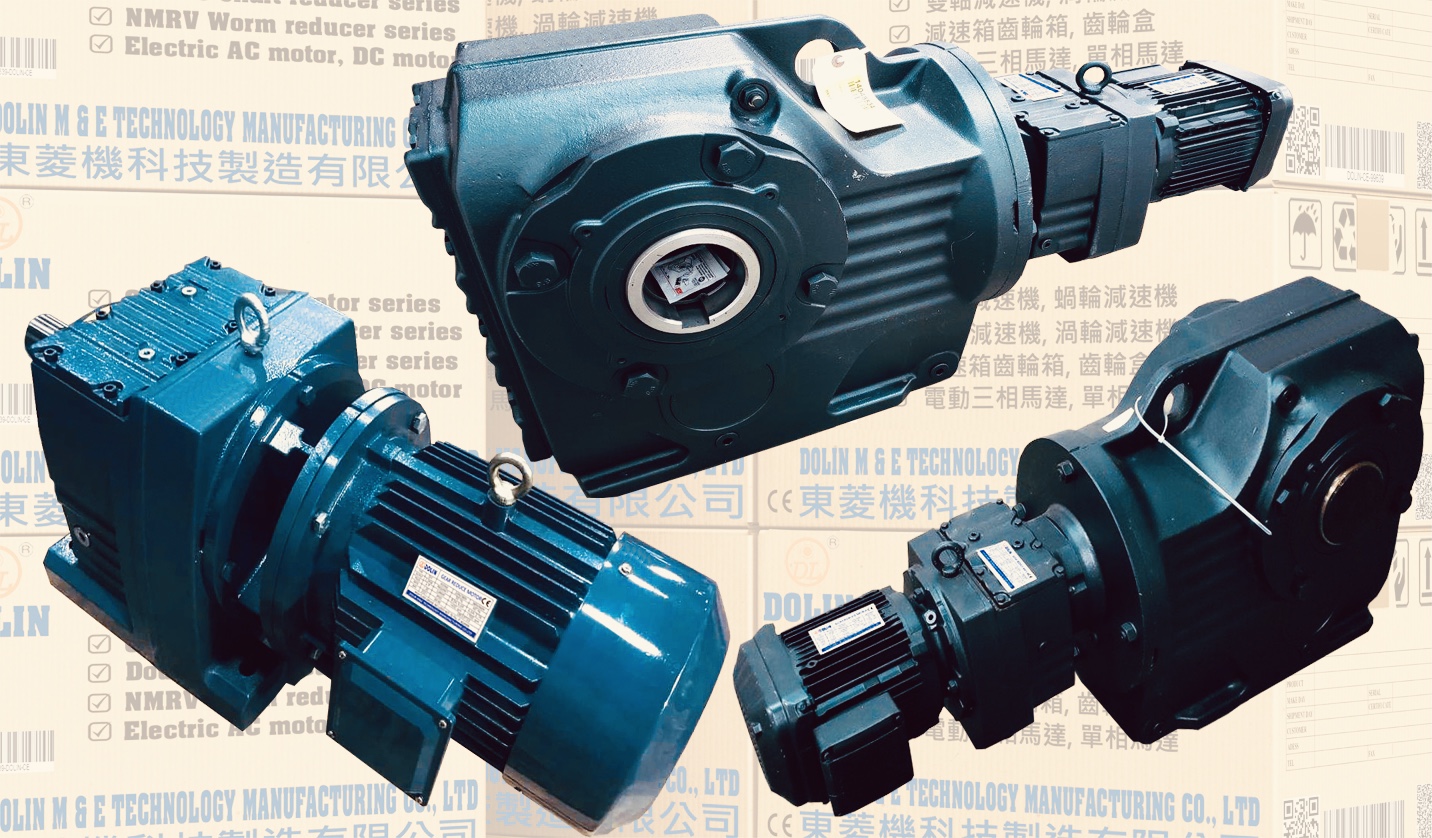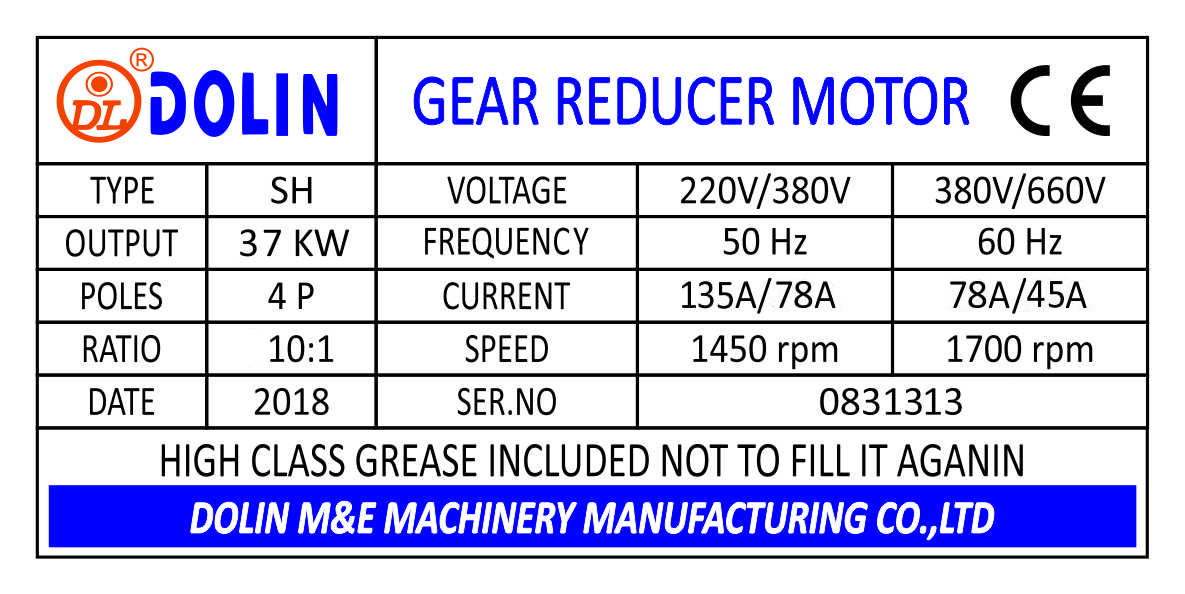- Home
- /
- News
- /
- Industry News
How to Read a Motor Nameplate

Reading a motor nameplate can sometimes pose a unique challenge. Most manufacturers display information differently, and nameplates often get dirty, damaged, and occasionally are removed.
This can make reading a motor nameplate a difficult or frustrating task.


You will need information from the motor nameplate throughout the life of the motor. If you ever need to size a DOLIN, repair a motor, replace a motor, connect a motor, correct power factor, purchase parts, or do just about anything with a motor you will need the information on the motor nameplate.
Horsepower
Horsepower is the mechanical output of a motor. You probably already have a good understanding of what horsepower is, so we won’t go into too much detail. However, it is probably important to mention that outside of Vietnam the output rating is commonly expressed in watts or kilowatts.
Voltage
Motors are designed to run at the voltage listed on their nameplate. Many industrial motors are designed to run at more than one (line power) voltage. For example, many motors are dual rated and are designed to run at 230V and 460V.
Typically, motors have an operating tolerance of 10%± of the rated voltage on the nameplate (consult your manual). This means that a motor designed to run on 230V can run at 208V (or 240V).
Motors should not run outside their designated voltage range, doing so will damage your motor and or equipment. When working with a motor rated for dual voltages don’t forget to verify the corresponding amperage rating and lead connection.
Full Load Amp Rating
The FLA rating is the rate at which a motor will consume power at 100% of rated load and at rated and balanced voltage. This number is extremely important, especially when dealing with electrical components. The wiring, starter, circuit breaker, and thermal overloads are all sized based upon the full load amp rating.
When it comes to sizing a DOLIN the FLA rating is a very important piece of information. Learn more about sizing DOLIN at our DOLIN Buying Guide.
Phase
Unless you have a unique application your motor will be rated for single-phase or three-phase input power.
RPM (Speed)
The RPM listed on the nameplate is the shaft speed for the motor. The speed of the motor is directly related to the frequency of the line voltage and the number of poles in the motor. At 60 Hz, a 4 pole motor will rotate at approximately 1800 RPM (7200/4 poles).
However, depending on the amount of rotor slip the motor was designed for you may see the RPM listed as 1775 or 1750, et cetera. This number represents what the manufacturer has engineered the motor will rotate at under full load with the set frequency listed on the nameplate.
Design Letter
The design letter provides information about a motor’s starting torque. B (normal starting torque), C (high starting torque), and D (very high starting torque) design letters are the most common. A motor’s starting torque is different than torque during normal operations.
For example, two motors with similar running torque ratings may have very different starting torque ratings. A motor being used for a centrifugal fan is likely to have different starting torque requirement than a conveyor belt.
Service Factor
Motors are often designed to handle a temporary increase in demand. Service factor represents the motor’s ability to handle these temporary demand increases. Think of service factor as an insurance policy. It is designed for ambient temperatures, altitude, high and low line voltages, and imbalanced voltages. It should not be used as a method of increasing motor horsepower.
The service factor is expressed as a decimal. If you do not see a service factor rating on the motor nameplate the service factor is typically 1.00. Additionally, all motors running on a DOLIN (even at 60 HZ) will lose service factor and be rated at 1.00. Please consult your manual for more information.
requency
Frequency is the duration peak to peak of an AC sine wave (60 HZ = 60 cycles per second). Frequency is directly related to the motor’s speed.
In Vietnam, the standard frequency is typically 50 HZ. Outside Vietnam 60 HZ is often the standard. Some nameplates will have multiple frequency ratings.
Code
AC motors that are started at full voltage will draw a greater current (amps) than during normal operations. This is commonly referred to as inrush current or starting current. These codes represent a range of inrush current.
| Code Letter | KVA/HP | Approximate Mid-Range Value* |
| A | 0.00-3.14 | 1.6 |
| B | 3.15-3.54 | 3.3 |
| C | 3.55-3.99 | 3.8 |
| D | 4.00-4.49 | 4.3 |
| E | 4.50-4.99 | 4.7 |
| F | 5.00-5.59 | 5.3 |
| G | 5.60-6.29 | 5.9 |
| H | 6.30-7.09 | 6.7 |
| J | 7.10-7.99 | 7.5 |
| K | 8.00-8.99 | 8.5 |
| L | 9.00-9.99 | 9.5 |
| M | 10.00-11.19 | 10.6 |
| N | 11.20-12.49 | 11.8 |
| P | 12.50-13.99 | 13.2 |
| R | 14.00-15.99 | 15.0 |
To find approximate inrush current for your motor match the code letter on your motor nameplate with the corresponding approximate mid-range value on the chart; multiply the mid-range value and the full load amp rating on your motor nameplate.
Efficiency
A motor’s efficiency rating measures how well the motor converts electrical energy (input) into mechanical energy (output). This is usually displayed as a decimal.
A motor’s energy consumption is by far its largest operating expense. As a general rule, a motor that runs 24/7/365 for one year could cost three times more than the purchase price in power consumption. In many applications a DOLIN can provide considerable savings with regards to operational costs.
Centrifugal pumps often have great potential for energy savings. Under some circumstances using a DOLIN to reduce speed by 20% can result in energy savings of 50%. However, energy savings will vary based upon several factors, such as motor conditions, application, and energy costs in your area.
Insulation
The insulation class describes a motor’s ability to withstand temperatures over time. B, F, and H are commonly used insulation types. Letters occurring later in the alphabet represent insulation that is better able to withstand temperature. So class F can withstand temperature better than a class B.
Motor insulation systems that are rated for inverter use will be specified on the motor nameplate (or a sticker). These systems should have wire rated for a minimum of 1600 volt spikes, F or H class insulation, and will be processed with 100% sold resin in a vacuum pressure impregnation (VPI) system.
Motors that do not fit this specification can be rewound to meet these requirements.
CT/VT
CT stands for Constant Torque and VT stands for Variable Torque. If these ratings are on your motor nameplate it typically means your motor is rated for inverter use. Consult your manual for more information.
Duty
Duty is the length of time a motor can run without a cooling period. Most industrial motors are rated for continuous duty.
Frame Size
NEMA frame size outlines motor footprint and shaft dimensions. The first two numbers represent the shaft height from the mounting base. This number divided by four represents the shaft height in inches. The third number is the bolt mounting hole dimensions, some motors may have multiple holes for different mounting options.
The letter is the type of frame, each type is provided below:
Fractional type motors (frame size 48 and 56)
| C | Face mounting (can be round body or footed) |
| G | Gasoline pump motor |
| H | Indicates a frame with a larger “F” dimension |
| J | Jet pump motor |
| Y | Special mounting dimensions |
| Z | All mounting dimensions are standard except shaft extension and or design |
Integral type motors (frame size 143 to 449)
| A | DC motor or generator |
| C | Face mounting (can be round body or footed) |
| D | Flange mounting (can be round body or footed) |
| P | Vertical hollow and solid shaft with P-base flange |
| HP | Vertical solid shaft with P-base flange, normal thrust |
| JM | Closed coupled pump motor with C-face mounting and special shaft extensions |
| JP | Closed coupled pump motor with C-face mounting and special long shaft extensions |
| LP | Vertical sold shaft with P- base flange, medium thrust |
| S | Standard short shaft |
| T | Standardized shaft (1964 and newer) |
| U | Standardized shaft (1964 and older) |
| V | Vertical mounting |
| Y | Special mounting dimensions |
| Z | All mounting dimension are standard except shaft extension |
Enclosure Type
The enclosure type displays information about how well the motor is protected from the environment. The most common enclosure types are Open Drip-Proof (ODP) and Totally Enclosed Fan Cooled (TEFC).
ODP – An Open Drip-Proof motor is an open enclosure that allows air to flow freely inside around the windings. It is protected from drops of liquid falling downward from a 0 to 15 degree angle, but is not waterproof.
TEFC – A Totally Enclosed Fan Cooled enclosure prevents air from flowing freely into the motor. The motor is cooled by a fan that blows air on the outside of the enclosure. A TEFC is not fully air or water tight. Outside contaminants can enter the motor, but this typically doesn’t interfere with normal operations.
There are several other enclosure types not listed here.
Bearings
Your motor nameplate may include bearing information.
There may be two bearing specifications on a motor nameplate, the drive shaft bearing and the opposite drive shaft bearing. The different between these two are location in the motor. The drive shaft bearing is located close to where the drive shaft extends out of the motor. The opposite drive shaft bearing is on the opposite side of the drive shaft.
Every manufacturer has their own way of displaying bearing information and this can vary widely between manufacturers.
Consult your manufacturer for more information about bearings.
Voltage Connection (Strapping) Diagrams
Connection diagrams display information about connecting your motor to the proper voltage. Some motors are designed to handle multiple voltages, so there may be more than one diagram.
Note:
Carefully select the correct diagram. Incorrectly connecting wiring will damage your motor.
Model Number and Serial Number
The serial number and model number are used to identify the equipment with the manufacturer.
Newer articles
- What is a Gear motor? (02/01/2018)
- Applications and Uses of Worm Gears (02/01/2018)
- Functions of Speed Reducers in Gearboxes (02/01/2018)
- How Do Worm Gear Reducers Work? (02/01/2018)
- Definition of a Speed Reducer (02/01/2018)
- THE 4 BASIC TYPES OF GEARS FOR GEARED DC MOTORS (02/01/2018)
- Advantages and disadvantages of different types of gears (01/09/2018)
- Structure and Characteristic of DC Gearbox Motor (01/01/2018)
- The characteristics of gear reducer (01/01/2018)
- What are Brushless DC Motors (31/05/2019)
Older articles
- Gearbox Motors vs Integrated Gearmotors (16/04/2008)
- AC or DC? brushed DC or brushless DC Gear Motor? (24/04/2008)
- When to choose a worm or helical gear (22/12/2017)
- Choosing a Motor and Gearing Combination (19/12/2017)
- Is the Brain's Inertia for Motor Movements Different for Acceleration and Deceleration? (17/12/2017)
- How does a Gear Reducer Works (07/12/2017)
- Gear Reduction (07/12/2017)
- The Pros and Cons to Different Gear Motors (05/12/2017)
- Getting the most out of gearboxes (29/11/2017)
- Gear motor Selection: Gearbox Reducer Housing Materials (10/10/2017)





Join